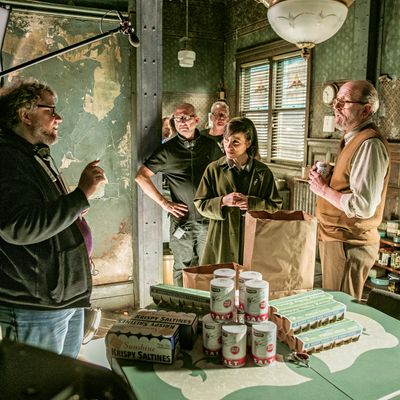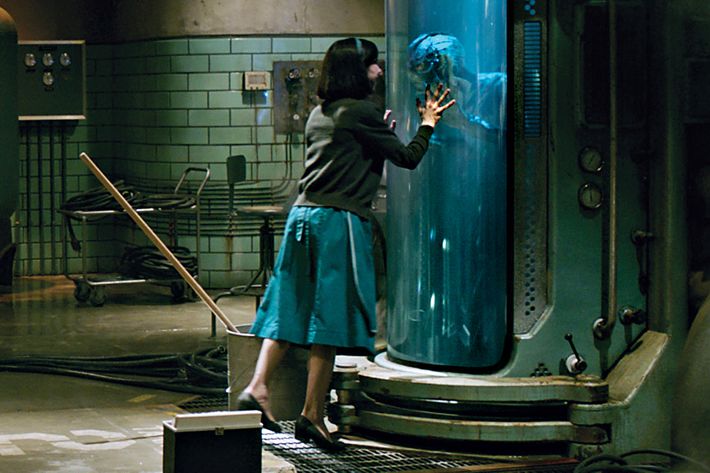
It’s been a strange year for Hollywood (to say the least), full of resistance and revelations. Still, the industry is determined to celebrate — and this week we look at a few of the performances, directors, achievements, and, in one case, prosthetic jowls most likely to be honored.
Guillermo del Toro finally got to live with his monsters nine years ago, when he was 44 and moved into what he calls Bleak House, in Thousand Oaks, a planned community with a golf course about an hour outside of Los Angeles. It serves as his office — he lives in a similarly anonymous home nearby — but also as a personal retreat, a private museum, and a “man cave,” as he puts it, filled with a reference library of books about his various interests (vampires, fictional; vampires, real; gothic romance; anatomy). Every surface is systematically covered with models and drawings and pictures and relics and props from the darkly enchanted horror-world of his films. It’s “a place that the neighbors don’t know what I do,” he says, greeting me in the foyer under a large painting of Saint George slaying a dragon, a statue of a fanged hellhound frozen mid-stalk behind him.
The only window in his office is a fake one modeled after the Haunted Mansion at Disneyland; when turned on, it gives the impression of a gloomy, perpetual rain. “It’s really soothing,” he assures me, as we sit down on his beige sofa. This is where he says he does his writing, with a life-size statue of a seated Boris Karloff in perpetual tea-sip over his shoulder.
Usually there are more creatures and things on the walls, but, he notes, “most of the stuff in this room is traveling in the museum show” — an exhibition called “Guillermo del Toro: At Home With Monsters,” currently at the Art Gallery of Ontario. “I miss Schlitzie from Freaks coming down the stairs,” he says, shaking his head. “I do miss him.”
Del Toro, personally, isn’t particularly goth: He’s a hugger, endlessly solicitous, who comes across more as a suburban dad than the big-shot Hollywood director of Hellboy, Pacific Rim, and Pan’s Labyrinth, as well as the co-creator of the FX vampire-plague series The Strain. We’re here to discuss his new film, a Cold War–era interspecies fairy tale called The Shape of Water, the pitch for which might be Beauty and the Beast meets Creature From the Black Lagoon. Only this time, the beast remains beastly and the creature gets the girl, which is what young Guillermo fantasized about when he first saw Black Lagoon, at age 6. In The Shape of Water, an Amazonian river god that looks like a human-salamander hybrid is captured by the military and brought back to a bunker where he is experimented on and brutalized by Americans seeking supernatural advantage over the commies. There the monster meets Elisa, a mute cleaning staffer played by Sally Hawkins; the two recognize something in each other, and a kind of tank-to-human romance blooms.
“It’s a movie that I had in my head for many years,” del Toro says. “The idea that I can do a Beauty and the Beast where the beauty is not a princess and the beast doesn’t need to transform to make the love worthy. When I read the classical inception of Beauty and the Beast, I always think they are on equal terms. Nobody can see past his ugliness, and nobody can see past her beauty. Both are very different burdens, but they are burdens all the same. She cannot be seen as intelligent, complex, capable of darkness, for the same reasons that he cannot be seen as capable of love or kindness.”
He’s called it a “fairy tale for troubled times” and an “antidote to now,” but the idea is much more basic to del Toro, too. When I ask if he uses the pool presided over by a big octopus statue I spotted out back, he tells me, “Despite my size, I’m really fast and I’m a good swimmer. You know how people dream they can fly? I’ve always dreamt I’m underwater since I was a very young child. It’s the one lucid dream I still have.”

Ever since he was a child, when he was beset by lucid dreams and night terrors, del Toro has always taken the side of the monsters. They’re outsiders, saints of a sort (he was, after all, raised Catholic in Mexico), and therefore purer than the fallen humans of, as he once wrote, the “adult world,” which was “almost entirely composed of lies.”
He was born in 1964 in Guadalajara, the son of a tarot-reading mother he’s called “a bit of a witch” and a businessman father he’s called “the most unimaginative person on earth.” In 1968, his father won the national lottery, invested the money successfully in Chrysler distributorships, and moved the family into a mansion. Young Guillermo watched horror films, read fanzines like Famous Monsters of Filmland — at 7, he even wrote its editor, asking to be adopted — and experimented with his father’s Super 8 camera. His Catholic maternal great-aunt, who helped raise him, would throw holy water on him to try to exorcise what she saw as the demons that had taken possession of his mind — or at least his notebooks, which were full of drawings of all manner of supernatural beasts. “Of course, there is a very lurid side to the cosmology of Catholicism, and that translates directly,” he says. Bullied as a kid, he figured out how to live a life of scary make-believe.
After graduating from film school in Mexico, in 1983, he spent ten years as a special-effects makeup designer, then made his first feature film, Cronos, about a girl and her beloved vampire grandfather. It won an award at Cannes, and he became friendly with James Cameron. In 1997, Miramax gave him $30 million to make Mimic, about genetically altered insects that turn against their human masters. He wasn’t happy with the film, which was reedited to infuse it with what he’s called “cheap scares.” He decided not to let that happen again. “After Mimic, I’ve had complete freedom,” he tells me. “So if you like or dislike anything I do, I cannot blame anyone but myself.”
The release of Mimic was accompanied by a real-life horror: His father was kidnapped off the street in Mexico. He paid the ransom with the help of a loan from Cameron. Then he moved his family to the United States. Since then, he’s made movies in Spanish (like 2001’s The Devil’s Backbone, which, like Pan’s Labyrinth, is set during the Spanish Civil War) as well as English. He’s had other big projects that never got off the ground, like his version of Frankenstein. But the real heartbreaker was his adaptation of the H. P. Lovecraft novella At the Mountains of Madness, about some explorers who come upon the ruins of a nonhuman civilization in Antarctica and accidentally awaken something darker. “That took a year and a half of my life, in storyboarding, budgeting,” he says. And very much in public: The planning for it took up a large portion of his 2011 New Yorker profile, only to come to naught.
Recently he had to give up on a version of Pinocchio set during the rise of Mussolini. I ask him why he’s drawn to Pinocchio, and he says he equated him with Frankenstein. “The interesting thing to me is that they are both a blank. I would say a creature of pure essence thrown into a world where the notions of good and evil are completely alien to them, and they’re created by an uncaring father that then doesn’t really guide them through it. They go into this adventure of discovery of self. ‘What is good, what is bad, what am I? Why does the world feel so alien to me?’ ” This seems to be del Toro’s journey, too. Frankenstein is “to me the patron saint of imperfection that gets literally crucified for our sins. He goes to the martyrdom of torches and stones because he doesn’t conform to the idea of normal. To me, as a kid, as a young boy, he had a redemptive energy. That’s part of empathy for monsters as a child. This part of empathy I tried to provoke in Shape of Water.”
The film is set in 1962 for a reason. “Because in 1962 a certain idealized version of America crystallizes and then stops,” he says. “You know, in ’62, ’63, is the apex of the postwar opulence, suburban wealth, a car in every garage, TV, TV dinners, self-cleaning kitchens, hair spray and petticoats, Cadillacs with fins. Then that dream is vacated by the escalation of the Vietnam War and the death of JFK.” Big themes for an interspecies Beauty and the Beast, but del Toro has never shied from them, even if surrounded by his collection of figurines.
But it’s also a film about tolerance, which may be why, despite its darker moments, it’s considered an anomalous feel-good candidate for this winter’s awards season, in a crowd of movies that have, one by one, been drafted into political debates: The Florida Project (income inequality), Three Billboards (sexual assault), Get Out (racism), Dunkirk (the return of fascism). In most ways, The Shape of Water is an old-fashioned love story, with the Creature from the Black Lagoon as the brooding, misunderstood leading man. This is helped along a bit by the fact that, frog eyes aside, he’s designed, as del Toro explains, after “Michelangelo’s David … a perfectly proportionate god of the water that has a swimmer’s body.” Del Toro hopes that it’s a monster you can fall for, and he makes his case: “You can every day choose between fear and love,” he says.
*This article appears in the November 27, 2017, issue of New York Magazine.



